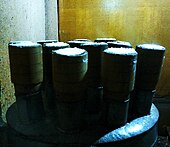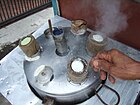Kue putu
 Kue Putu, filled with palm sugar and served with desiccated coconut. | |
| Alternative names | Putu bambu, putu bumbung |
|---|---|
| Type | Sweet dumpling |
| Course | Dessert, snack |
| Place of origin | Indonesia |
| Region or state | East Java |
| Serving temperature | Warm or room temperature |
| Main ingredients | Rice flour,palm sugar, coconut |
| Similar dishes | Puttu,puto,puto bumbong,kueh tutu,mache |
Kue putuorputu bambuis anIndonesiankue.[1]It is made ofrice flourcalledsujiand coloured green withpandan leaves,filled withpalm sugar,steamed inbambootubes (hence the name), and served with desiccatedcoconut.This traditional bite-sized snack is commonly found inmaritime Southeast Asia,particularly inJava,Indonesia, where it is calledputu bumbung. Kue putuis usually sold by street vendors and can be found in traditional markets, along with otherkues. Kue putucan also be found in the Netherlands due to its colonial ties withIndonesia.[2]
Ingredients and cooking method
[edit]It consists of rice flour with green pandan leaf colouring, filled with ground palm sugar. This green coconut-rice flour ingredients with palm sugar filling is filled into bamboo tube container. Subsequently, the filled bamboo tubes are steamed upon a steam cooker with small holes opening to blow the hot steam. The cooked tubular cakes then pushed out from the bamboo tube container, and served with grated coconut.
Etymology and variations
[edit]
In Javanese,bumbungmeans "bamboo" or "a hollow cylindrical object; a tube". As the dish began to spread across the country, the name was later translated to Indonesianputu bambu(bambu: "bamboo" ). Hence the name, as it is made by filling a bamboo tube with the ingredients (see the above picture).

Variations ofkue putuare often in the shapes or fillings.Kue putuof different shapes with almost identical ingredients, fillings and recipes exist in Southeast Asia.
The white-colored, flatter disc-shapedputuis calledputu piring(Malayfor disc/plateputu) and is more common in Malaysia,KeralaandSri Lanka,while thicker and more round white- or green-colouredputu mangkok(Indonesianfor bowlputu) is found more in Indonesia. In Singapore, however,putu mangkokis calledkueh tutu.
Traditionallykue putuis filled with palm sugar. Today, however, there are several new variations using different fillings, such aschocolateorabon(beef floss).[3]
Similar dishes
[edit]In the Philippines,putorefers to a class of pastries made by steaming rice. A type ofputovery similar tokue putuisputo bumbóng,which is also cooked in bamboo tubes (Tagalog:bumbóng). However,puto bumbóngdoes not use pandan and is traditionally cooked from whole grains, rather than rice flour. It also uses a special, purple variety ofglutinous ricecalledpirurutóngwhich gives it a deep, purple colour (nowadays achieved withfood dye).[4]
In India (Kerala,Tamil Nadu andKarnataka) and Sri Lanka, a similar dish is known asputtuorpittu,though the dessert variety is only predominant in Tamil Nadu.[5]
See also
[edit]References
[edit]- ^Anggara Mahendra (13 June 2013)."'Kue Putu' Steamed Green Cake ".Baily Daily.Archived fromthe originalon 15 June 2015.Retrieved12 June2015.
- ^"Kue Putu Bambu".Waroeng.Retrieved12 June2015.
- ^Rusaidah (20 February 2012)."Kue Putu HJ Bangka Hadir dengan Tiga Pilihan Rasa"(in Indonesian). Bangka Pos.Retrieved12 June2015.
- ^Angelita M. del Mundo (1995)."Emerging Versions of Some Traditional Philippine Rice Food Products".In Harlan Walker (ed.).Disappearing Foods: Studies in Food and Dishes at Risk.Proceedings of the Oxford Symposium on Food and Cookery 1994. Prospect Books. p. 64.ISBN9780907325628.
-Amy Besa & Romy Dorotan (2014).Memories of Philippine Kitchens.Abrams.ISBN9781613128084. - ^BBC Indian Food Made Easy: Recipe for puttu,BBC, archived fromthe originalon 24 December 2008,retrieved13 August2010







